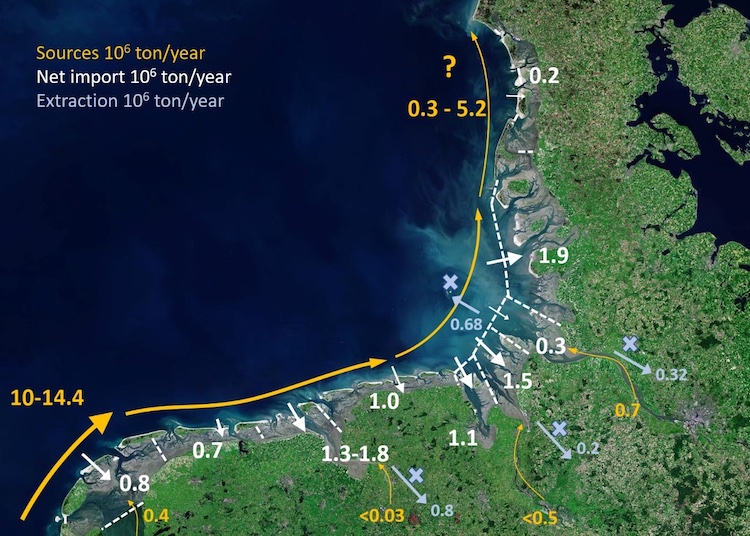A. Colina Alonso1,2*, A. P. Oost3, P. Esselink5, Z. B. Wang1,2, T. van Kessel2, D. S. van Maren4,1,2
1 TU Delft
2 Deltares
3 Staatsbosbeheer
4 SKLEC, ECNU
5 PUCCIMAR
*
The Wadden Sea is an extensive barrier-lagoon system covering Dutch, German, and Danish territory. Although being an important nature reserve, the area also provides important economic services. The area is strongly influenced by human interventions – especially by successive land claims in the past, and more recently, by facilitating economic development along the three main estuaries intersecting the tidal basins (the Elbe, Weser and Ems).
Recent estimates suggest that mud (<63 µm) deposits make up about 10-30% of the total volume of recent deposits in the Wadden Sea, thus playing a significant role in its sedimentary development. Fine sediments mainly deposit on intertidal mudflats fringing the coastline or tidal divides, providing among others important feeding habitat for migratory wading birds. Mud also deposits on the salt marshes, contributing to the important ecological services provided by these systems, and protecting the dikes and therefore the hinterland against flooding. It may significantly contribute to the basin's ability to keep up with Sea Level Rise (SLR), which implies that fine sediments may become an important commodity in the future, fuelling the need for a quantitative mud budget for the Wadden Sea.
This research presents the first attempt to establish a mud budget for the Trilateral Wadden Sea, providing detailed estimates for mud sinks, sources, and transport. It is based on a combination of existing literature, bathymetric charts, sediment composition maps, observed deposition rates, and dredging information. The total supply of mud to the Wadden Sea is estimated at 12.1-16.5×106 ton/yr. Mud is mainly deposited in areas where strong anthropogenic disturbances prevail, such as the Western part of the Dutch Wadden Sea (closure of the Zuiderzee), along the mainland, and in sheltered embayments. The total amount of mud depositing in the system (both naturally and through anthropogenic sediment extraction) is estimated at 10.8-11.3×106 ton/yr. This implies that currently the sediment supply is only 1.1-1.5 times larger than the net total sedimentation + extraction.
We show that mud is a crucial component in the morphodynamic behaviour and the sediment budget. On a large scale there is a constraint on the amount of mud that can be extracted from the system, especially considering the expected acceleration of SLR. Locally, enough mud may be available, but in time shortages may develop. Sustainable sediment management strategies including sediment extraction should account not only for the local impact, but also the large-scale, long-term implications.

Figure 1: Conceptual figure of the mud budget for the Wadden Sea area (Oost, et al., 2021).
I. Surname1*, F.N. Another-Surname2 , Y. Next-Surname2
1 University Name, Country; 2 Organization Name, Country
* Corresponding author: mail.name@organization.org


